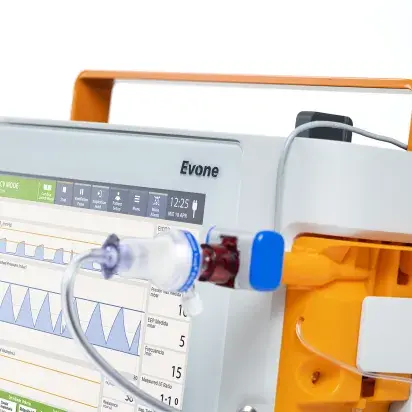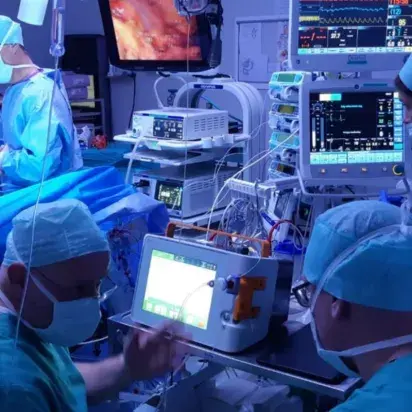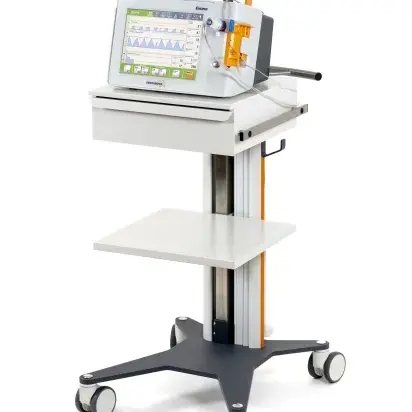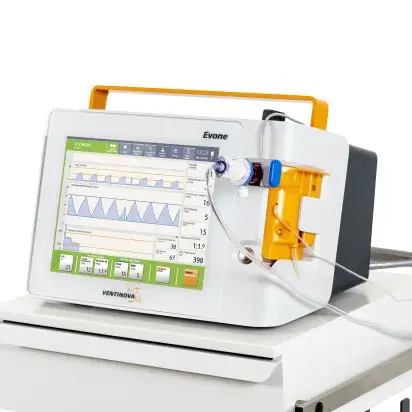Flow Controlled Ventilation (FVC®)
Evone®
The only mechanical ventilator that offers control of the entire ventilatory cycle.
Evone® is the only ventilator on the market using the patented FCV® mode.
Ensures complete control of both inspiratory and expiratory phases in anesthetized patients.
- Evone’s FCV® ventilation mode is unique in creating a stable gas flow into and out the patient´s lungs to generate an inspiration and expiration, respectively.
- FCV® is a dynamic ventilation mode, without pauses, aiming for linear changes in both volumen and pressure.
- FCV® prevents abrupt intrathoracic pressure drops by means of the controlled expiration.
- Ventilation is guided by intratracheal pressure measurements and controlled by a pressure, Compensated flow controller.
- Inspiration is performed with the set constant Inspiration Flow until the intratracheal pressure reaches the set Peak pressure.
- Evone® then starts an actively supported expiration phase resulting in controlled decline in intratracheal pressure until EEP with the set I:E is reached.
- Evone® provides a meticulous dynamic measurement performed during both inspiratory and expiratory flow
- Such reliable lung-mechanical data even permits a unique way of individualized ventilation
Ventilating with Evone®| BENEFITS
The following benefits as compared to volume controlled ventilation (VCV) and pressure controlled ventilation (PCV) may be expected while ventilating patients in FCV® mode:
Lineal increase and decrease in intratracheal pressure
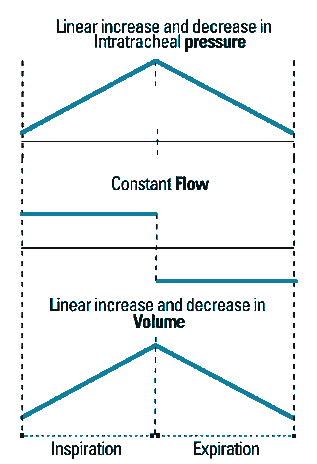
FUGURE: FCV® has an entirely dynamic flow profile, without pauses, aiming for linear changes in both volume and pressure. There are no abrupt intrathoracic pressure drops because of the controlled expiration.

FIGURE. Setting flow-controlled ventilation requires four parameters:
1) end-expiratory pressure, 2) peak, 3) inspiration flow and and 4) I : E ratio.
At the set flow rate gas is insufflated from end-expiratory pressure (EEP) until it reaches peak level. Then the flow is reversed and sucked out at the rate to reach the set I : E ratio until EEP is reached. The next insufflation follows.
Evone Settings configuration
(1) Inspiration Flow, (2) I:E ratio, (3) Peak pressure y (4)EEP (end expiratory pressure)
- The set inspiratory flow and the I:E ratio determine a patient minute volume and the frequency.
- Set Peak and EEP determine the inspiratory tidal volume and the frequency.
- Note that Frequency, Minute Volume and Tidal Volume are the results of parameters settings ( not set directly)7,8
- The FCV ventilation cycle is governed by four ventilator settings only.
InspirationFlow and I:E ratio, affect Minute Volume and Frequency
| Higher Inspiration Flow > | Higher Minute Volume and Higher Frequency |
| Longer Expiration > | Lower Minute Volume and Lower Frequency |
Peak Pressure and EEP determine the Inspiratory Tidal Volume and Frequency
| Higher Peak Pressure > | Higher Minute Volume and Higher Frequency |
| Lower EEP > | Lower Minute Volume and Lower Frequency |

Endotracheal Tubes
Evone® enables Fully-Controlled Ventilation of a patient using various endotracheal tubes (< 3 mm ID to ~10 mm ID).
Tritube®
The ultrathin endotracheal tube, (< 3 mm Internal Diameter, 4.4 mm Outer Diameter) with an inflatable cuff to secure the airway.
Developed by Ventinova for small lumen – FCV® ventilation mode.
- Difficult airway
- Head (Maxillofacial) and Neck (ENT) Anaesthesia
- Tracheal surgery
- Tracheostomy
Evone® is intended to be used in operating rooms and ICU environments in hospitals. All patients >40 Kg. IBW
*The benefits of FCV® relating to ventilation efficiency or low energy is not influenced by the use of the CTA with a conventional endotracheal tube or Tritube®.
* FCV® ventilation can only be applied when the cuff of the endotracheal tube is fully inflated, sealing off the trachea from the ambient atmosphere and with total intravenous anesthetized (TIVA) patients.
Conventional Tube Adapter (CTA)*
CTA enables FCV® in the operating room and intensive care unit with an easy connection to any conventional endotracheal tube (size 5-10 mm ID).
Connection to conventional single lumen tubes:
- Improves ventilation efficiency in any surgery compared with conventional ventilation modes.
- FCV® results in smooth tidal movements of the diaphragm and thoracic wall.
- Coronary Artery bypass
- Lung or oesophageal surgery
- Laparoscopic or robotic abdominal surgery
- Radiofrequency procedures (cardiac, liver or pancreatic)
(Optionally use inspiration hold to mantain PEAK pressure or ventilation pause to mantain EEP pressure) - Connection to Double lumen tubes to allow one and two lung ventilation.
- Connection to (laser resistant) MLT-5 and MLT-6 during laryngeal surgery.
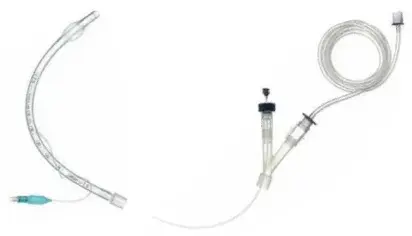
Jet Ventilation
Jet mode
Additionally, Evone has a (High Frequency) Jet Ventilation mode, which requires an open airway.
The Jet cycle is governed by three operator settings being:
- Frequency
- Inspiration Percentage
- Driving Pressure
The maximum driving pressure is limited to 1.5 Bar.
- Jet Mode, can be postoperatively used to liberate the patient from FCV® mechanical ventilation with Tritube® to stimulate spontaneous breathing. The cuff of Tritube® should be fully deflated to enable expiratory gases to freely egress.
- Double lumen laser Jet catheter.
Jet Mode intratracheal pressure: typical sequence of Jet breathing cycles is shown.

Master the future of ventilation
Join Ventinova Academy
Our courses cover everything you need to know about Ventinova’s innovations including:
Cricath®, Ventrain®, Tritube®, Evone® and the clinical applications of FCV®.
- Step-by-step modules
- Practical user learning
- Concluding with an assessment and certificate.

Documentation
Evone brochures
Documentation
Evone Quick reference card
Documentation
Instructions of Use
Documentation

